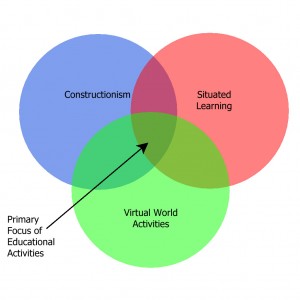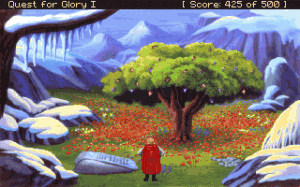Posts tagged edtech532
A Theoretical Model for Virtual Worlds in Weber School District
0 I’d like to implement virtual worlds in Weber School District. Hopefully, I’m in a position to actually steer things in this direction, and make it happen and get beneficial results. My concern with the implementation is that Second Life itself has a minimum age of 16. Great for high school kids, but it leaves out anyone younger. Plus there’s safety and security policies in place that make it complicated. However, if we used OpenSim or another third party, self-hosted virtual world solution, we could have complete control over the server, albeit at a loss of the rich content in Second Life. In essence, we’re starting from scratch.
I’d like to implement virtual worlds in Weber School District. Hopefully, I’m in a position to actually steer things in this direction, and make it happen and get beneficial results. My concern with the implementation is that Second Life itself has a minimum age of 16. Great for high school kids, but it leaves out anyone younger. Plus there’s safety and security policies in place that make it complicated. However, if we used OpenSim or another third party, self-hosted virtual world solution, we could have complete control over the server, albeit at a loss of the rich content in Second Life. In essence, we’re starting from scratch.
This is why we must adopt a constructionist approach when addressing virtual world instruction. Constructionism is a form of constructivism where artifact creation is the product of learning. The way I see it, students themselves should be the primary creators of the content and build the sims, under the direction of the teacher. Lessons should be designed that teach the intended content while the student is in the process of constructing, and the lessons should be designed to support a situated learning framework. Identifying an appropriate context for the learning, and focusing on collaborative activities is important.
When implementing constructionist activities in Second Life or OpenSim, it’s crucial that the teacher facilitates and provides consistent scaffolding support to the students, especially when there are varying skill levels. This takes constant observance of the activities, and at no time should a teacher stand on the sidelines, but be actively engaged in the process. With this type of activity, it is important that the instructor be continually and intimately aware of everything going on, to facilitate the experience. During the activity, the teacher should consistently provide help or suggestions that ensure a smooth and effective learning experience.
Identifying the types of activities that support the constructionist mode of learning inside the virtual world will enable us to find the right balance that fosters optimal learning opportunities. I certainly realize that there are many other ways to learn in a virtual world besides building content. But this is a necessary model for Weber School District, due to our existing infrastructure.
The learning activities that should be implemented, necessarily should adopt this “situated constructionist” approach. This way, especially with the forthcoming mesh abilities of Second Life and OpenSim, drafting students could import their buildings into Second Life. 3d animation students could import their characters and models. Programming students could learn the Linden Scripting Language and code the simulations. The virtual world implementation will be autonomous, and draw upon effective learning theories to guide its educational development.
Related articles
- Why Open Sim will Dominate Virtual Worlds in Education (coolcatteacher.blogspot.com)
- Reflections on Immersive Virtual Learning (weber.k12.ut.us)
- Teaching and Learning Options in the Virtual World (gridjumper.net)

Making a Better World Through Games
0
Gamer on the verge of an epic win
In February 2010, Jane McGonigal gave a TED Talk on how gaming is not only a prominent feature of modern society, but an absolutely essential one. She cites statistics that demonstrate people become engaged in games more than any other activity, and follows up with an argument that has been echoed by educators interested in gaming for awhile: Since deep, immersed engagement is present in game playing, why not use games for learning?
McGonigal identifies four common aspects of gamers that can be called the “habits of heroes,” or traits successful real-life problem-solvers possess:
- Urgent optimism: Gamers believe in instantaneous action to solve problems. It is not always necessary that a deadline must be looming in the background, or that a time-sensitive result must be attained. Gamers tend to believe in prompt action to solve the game world problems.
- Social fabric: Gamers trust the community. Strong social bonds are formed particularly through multi-user game playing, raiding, questing, and adventuring. This cohesion forms relationships of dependence and reliability that are essential to group work.
- Blissful productivity: Gamers are happier to work hard at solving the problems in a game. And in conjunction with the large groups of people available in the game, a diversity of skills can be pooled together to tackle the problems.
- Epic meaning. Gamers desire to become involved in a common cause. The gamers believe in what they are doing, and are motivated to see an engaging game through to the end.
The elusive question is how do we make the real world like the game? Or more to the point of game design, how can we create games that instill in students an engagement and motivation in a cause that can be transferred to the real world?
First, students must be able to relate to the content. A part of what makes a good game interesting is that the matter is interesting to the player. If a gamer can believe in the cause, albeit a virtual cause, they are more likely to stay engaged and willing to see the game through to the end.
Although the content is relevant to the real world, it must not portray real-world quests in an unsolvable manner. For example, The River City Project is a 19th-century multi-user virtual environment (MUVE) in which students research and attempt to solve the problems of a society. Rather than tackle global-scale problems such as world hunger, the issues are localized and solvable.
Collaboration is key, and students should be encouraged to weave their part of the social fabric. In the aforementioned MUVE, students work together in teams. If games use a problem-based learning approach, problems that can be more easily solved in groups should be designed.
Watch the video below, and see what you think about her ideas.

Engaging Learners Through Video Game Principles
1In a TED Talk from 2010, Tom Chatfield describes seven aspects that lend to the creation of effective, engaging games. They can particularly be applied to how we learn in general. The video is shown below, and he starts describing the seven aspects around the 8:30 mark.
These ideas apply directly to how learning-oriented games can be designed, and to a large degree apply to the physical classroom environment as well. Chatfield’s list is as follows:
1. Experience bars measuring progress
Instead of assigning grades, some teachers have turned to an experience point system. This is a familiar aspect of games, and measures a student’s steady progression through tasks (or “quests”). This system can apply to traditional classroom learning as well, and a teacher could accomplish this by putting experience bars up on a board, or manage it with online student profiles. Experience points are great at measuring progress over time in a nuanced, quantified manner, perhaps moreso than a flat list of assignments on a student’s progress report can do.
2. Multiple long and short-term aims
Students should be allowed to participate and choose different types of quests. Different quests can lead to larger goals, but students should be allowed to guide their progress, and take ownership of what they choose to accomplish. With enough “subquests,” students feel as though they are continually progressing, and have a clear end in sight.
3. Reward for effort
This goes back to standard behaviorist principles. If desired behavior is rewarded, the behavior will be reinforced and more likely to be repeated. We shouldn’t punish students when they fail, but instead recognize their achievements as they learn. Games teach us that we should turn “failure” into “success not yet realized.”
4. Rapid, frequent, clear feedback
One of the advantages of games is that they allow players to link consequences to actions. Even in cases where a game’s storyline is progressive and linear, a clear cause-and-effect chain is implied. For open-ended games, the player can alter the state of the world through their own choices. It is essential to learning that students are given prompt feedback following activities, so they know if their attempt was successful, or what could have caused unintended outcomes.
5. An element of uncertainty
People should not always expect everything, and the consequences or outcomes should not always be expected. This adds to excitement and encourages people to keep coming back. When applied to education, it keeps students entertained and willing to keep engaging in the learning process.
6. Windows of enhanced attention
Find moments in a learner’s play where they will be most receptive to learning, and identify areas where learners will gain confidence as they play. This can relate to how Kiili (2005) describes flow theory, or the ideal state at which a participant is absorbed in the learning material, the optimal experience in which full attention is placed on the activity, and nothing else seems to matter. If we can create these types of experiences in our games, students will be more receptive to what is being taught.
7. Other people
Students will invariably possess different competency levels in any game they play, and as they learn, their skills will evolve at varying speeds. Hunicke (2005) discusses this at length as a mechanism for creating an effective gaming environment without disrupting player experience. A balance must be formed between the game’s ease and difficulty. In other words, the game must be “gamed” in such a way that learners are not bored or frustrated with the ease or difficulty.
References
Hunicke, R. (2005). The case for dynamic difficulty adjustment in games. Proceedings of the 2005 ACM SIGCHI International Conference on Advances in Computer Entertainment Technology, 429-433.
Kiili, K. (2005). Digital game-based learning: Towards an experiential gaming model. The Internet and Higher Education, 8(1), 13-24.

The Emotional Depth of Video Games
0 Watch the 2006 TED talk by David Perry shown below, and ask yourself if you’ve ever been emotionally impacted by a video game. For me, the answer is clear. I still reflect fondly on the hours upon hours I spent playing and replaying my old adventure and otherwise plot-driven games like King’s Quest, Quest for Glory, Indiana Jones and the Fate of Atlantis, Wing Commander, and others. I’ve always had an affinity for this type of game, where storylines drive the player to work their way through complex situations. Once the problems in the game are solved, the player emerges with very real feelings of satisfaction and accomplishment, knowing they have affected the progression of the story in some way, even if behind the scenes the game’s direction is more linear than open-ended. Often these stories convey very meaningful, thought-provoking, and emotion-evoking situations. I remember shedding a few tears at the end of Grim Fandango, and getting lost in the immersive worlds of Final Fantasy. As Perry says in his talk, a well-designed game will “seamlessly weave the user in the fabric of the virtual experience,” and that exactly what games have done for me.
Watch the 2006 TED talk by David Perry shown below, and ask yourself if you’ve ever been emotionally impacted by a video game. For me, the answer is clear. I still reflect fondly on the hours upon hours I spent playing and replaying my old adventure and otherwise plot-driven games like King’s Quest, Quest for Glory, Indiana Jones and the Fate of Atlantis, Wing Commander, and others. I’ve always had an affinity for this type of game, where storylines drive the player to work their way through complex situations. Once the problems in the game are solved, the player emerges with very real feelings of satisfaction and accomplishment, knowing they have affected the progression of the story in some way, even if behind the scenes the game’s direction is more linear than open-ended. Often these stories convey very meaningful, thought-provoking, and emotion-evoking situations. I remember shedding a few tears at the end of Grim Fandango, and getting lost in the immersive worlds of Final Fantasy. As Perry says in his talk, a well-designed game will “seamlessly weave the user in the fabric of the virtual experience,” and that exactly what games have done for me.
This is an aspect which must drive how we design all educational games. Not necessarily to the point where students are sobbing uncontrollably while they play, but presenting them with the opportunity to totally immerse themselves in the game, and tapping into what makes games such a unique form of learning: their ability to dig deeper into our minds and emotions that traditional learning media cannot reach.
 Gaming has shaped our culture, and how we see things. I identify with Michael Highland’s video shown in Perry’s talk, where he says, “When I’m driving down a road at sunset, I think this is almost as beautiful as my games are.” It’s been four years since I last played Oblivion, but every time I see a beautiful scene, such as fog covering the Wasatch Mountains, or the colorful landscape of Bryce Canyon, I instantly think, “This is just as beautiful as Oblivion.” Video games are adept at shaping and reprogramming our minds. The key is to use this for good, and use games to shape the brains of students in such a way that cannot be done with traditional media.
Gaming has shaped our culture, and how we see things. I identify with Michael Highland’s video shown in Perry’s talk, where he says, “When I’m driving down a road at sunset, I think this is almost as beautiful as my games are.” It’s been four years since I last played Oblivion, but every time I see a beautiful scene, such as fog covering the Wasatch Mountains, or the colorful landscape of Bryce Canyon, I instantly think, “This is just as beautiful as Oblivion.” Video games are adept at shaping and reprogramming our minds. The key is to use this for good, and use games to shape the brains of students in such a way that cannot be done with traditional media.
